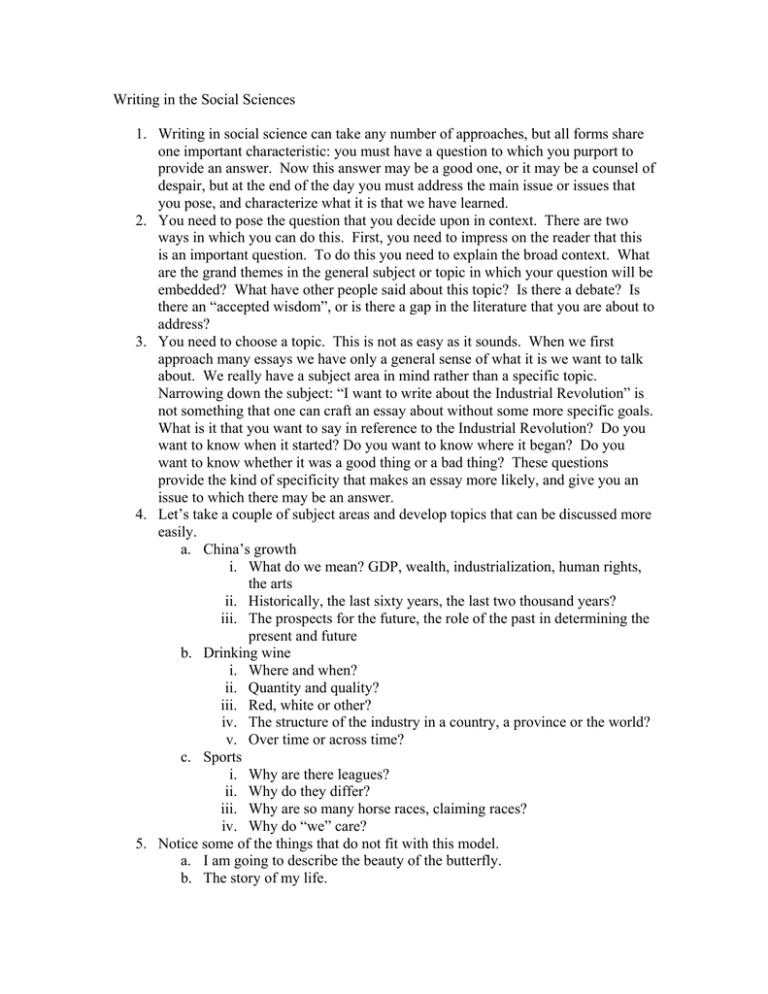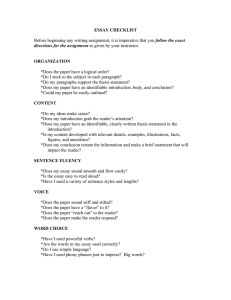Writing in the Social Sciences
advertisement

Writing in the Social Sciences 1. Writing in social science can take any number of approaches, but all forms share one important characteristic: you must have a question to which you purport to provide an answer. Now this answer may be a good one, or it may be a counsel of despair, but at the end of the day you must address the main issue or issues that you pose, and characterize what it is that we have learned. 2. You need to pose the question that you decide upon in context. There are two ways in which you can do this. First, you need to impress on the reader that this is an important question. To do this you need to explain the broad context. What are the grand themes in the general subject or topic in which your question will be embedded? What have other people said about this topic? Is there a debate? Is there an “accepted wisdom”, or is there a gap in the literature that you are about to address? 3. You need to choose a topic. This is not as easy as it sounds. When we first approach many essays we have only a general sense of what it is we want to talk about. We really have a subject area in mind rather than a specific topic. Narrowing down the subject: “I want to write about the Industrial Revolution” is not something that one can craft an essay about without some more specific goals. What is it that you want to say in reference to the Industrial Revolution? Do you want to know when it started? Do you want to know where it began? Do you want to know whether it was a good thing or a bad thing? These questions provide the kind of specificity that makes an essay more likely, and give you an issue to which there may be an answer. 4. Let’s take a couple of subject areas and develop topics that can be discussed more easily. a. China’s growth i. What do we mean? GDP, wealth, industrialization, human rights, the arts ii. Historically, the last sixty years, the last two thousand years? iii. The prospects for the future, the role of the past in determining the present and future b. Drinking wine i. Where and when? ii. Quantity and quality? iii. Red, white or other? iv. The structure of the industry in a country, a province or the world? v. Over time or across time? c. Sports i. Why are there leagues? ii. Why do they differ? iii. Why are so many horse races, claiming races? iv. Why do “we” care? 5. Notice some of the things that do not fit with this model. a. I am going to describe the beauty of the butterfly. b. The story of my life. c. Canada is my country…although there are possibilities here. d. What I feel about the way these things are: the post office, a hot dog, a bottle of wine. These are all reasonable things to write about and people get paid lots of money to do it, but it is not social science writing even though it may be very attractive and important to you and others 6. The first paragraphs are very important for setting the stage and although you may end up rewriting them at the very end, writing the first paragraphs often provides a good opportunity for thinking about your essay each time you approach it. 7. What goes into a first paragraph? First and foremost since it is the place where readers start you have some responsibilities. a. You have to capture the reader’s interest. Writing does not have to be boring. To be fair, you have to presume a certain amount of good will by the reader. You can’t expect an ignoramus to follow your essay.1 b. You must convince the reader that this is an important issue. There are many ways to do this although there is not one ‘correct’ way. Let me illustrate the way I think about it, but we will see other ways. i. Move from an extremely broad view of social science. See, for example, Irving Fisher’s Theory of Interest. ii. Move from there to more narrow issues. iii. Move to your issue. 8. Let us look at some examples: a. Fogel and Engerman b. Jones and Easton c. Kenneth Arrow d. Jared Diamond e. Psych f. Business g. Political science 9. Sometimes we are able to outline what it is we want to do with an essay, but we really find that at the end of the day we know what it is we want to say only after we have written the essay! a. Carlyle and the “The French Revolution” “The French Revolution was written in dramatic language bringing the history of the revolution alive in a way that few historians have ever done. Carlyle had to rewrite the book after he had sent the manuscript to John Stuart Mill, whose maid burned it - the only copy - for waste paper. Mill offered the author £200 compensation, he eventually accepted £100.” (http://www.globusz.com/history.html - April 19, 2006) b. Hopefully this will not happen to you: my hard disk crashed; my email folders disappeared; my floppy is unreadable. All of these suggest 1 This is a double edged sword. Harry Stack Sullivan, the famous psychiatrist, characterized the reader as a gremlin perched on his shoulder watching his words roll out. The gremlin could not understand anything but the most clearly expressed argument, yet could see endless qualifications to every point that Sullivan wanted to make. Sullivan is noted for his clarity and his extremely limited output. This has been a sad outcome for those who valued his ideas. something that you know, and I know, but let me remind you. Make a copy of original data and keep it “off site”: that is, off the computer with which you are working. Please try to back up. Back up! At worst, email it to yourself regularly. 10. What is it we strive to attain? A distinguished social scientist I know has said, “I would rather be clear and wrong, than right and unclear.” This is hard won knowledge and comes from reading critics who persistently misunderstand even the most finely honed and transparently explained arguments. What happens with difficult text is gratifying to generations of graduate students who can search footnote to find out what is “really meant”, but to this serious scholar, he damn well knows what he meant and he would really like everyone else to know too! Homework: Look through social science writing. Try a journal article rather than a book. Look at first paragraph(s) and ask how the author has organized things. Find four different examples. Which ones seem to work? Are some clearly better than others? Why is one better than another in your view? In this exercise we are not interested in content per se, but in exposition and clarity. Find an example of what you think of as a “good” introduction. Find an example of what you this of as a “bad” introduction.

